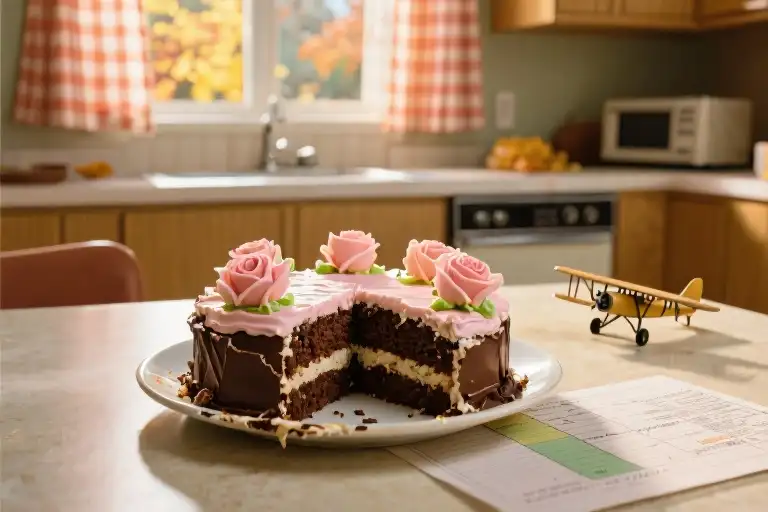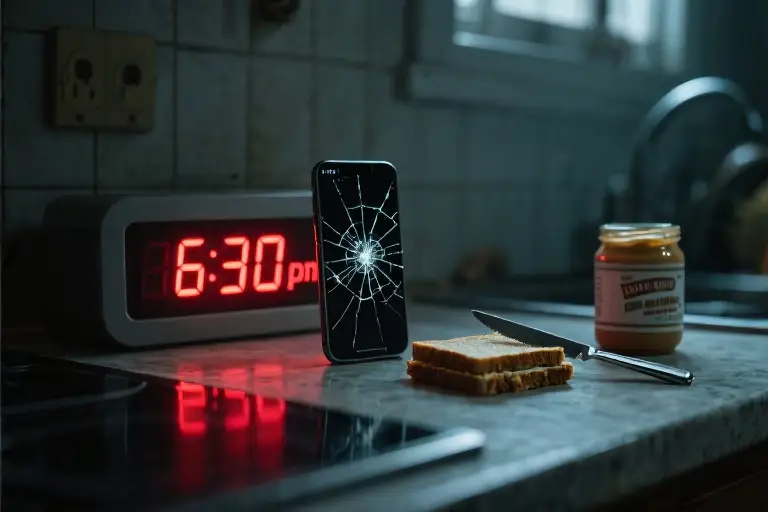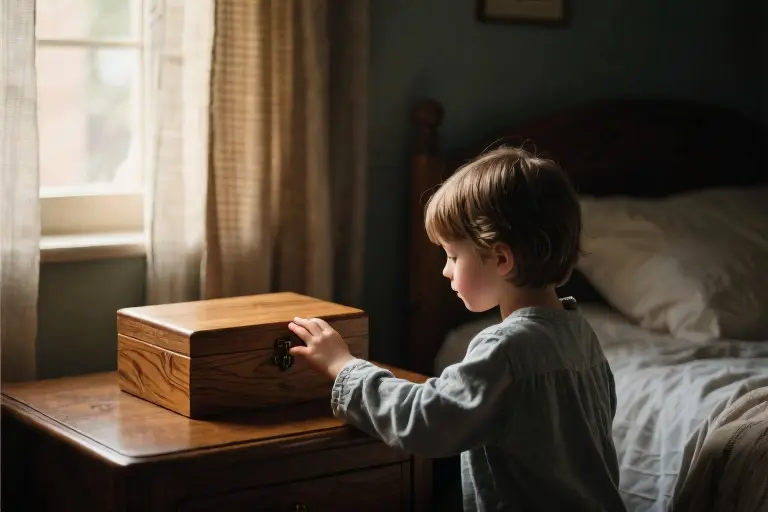The aroma of chocolate cake filled the house that Halloween afternoon in 1975, an unexpected scent amidst the candy corn and miniature chocolate bars scattered across the kitchen counter. Preschoolers in homemade costumes already patrolled the neighborhood, their plastic pumpkins clinking with early loot. Yet there stood my mother, apron dusted with flour, carefully pouring batter into round pans – a domestic scene so ordinary it felt almost defiant against the season’s spookiness.
‘Can I lick the bowl?’ I asked, eyeing the chocolate-streaked mixing bowl with the intensity of a treasure hunter.
‘Your brother already called dibs,’ Mom said without looking up from the oven, ‘but you can have the beaters.’
The unfairness stung. Those stubborn beaters with their coiled wires hid precious batter in impossible crevices, while the smooth ceramic bowl offered easy access to every last smear of sweetness. Still, I accepted the inferior prize, scraping the metal tines against my teeth with practiced precision. ‘What’s the cake for?’ I mumbled through a mouthful of batter.
‘Larry’s birthday tomorrow,’ she answered, swatting my wandering fingers away from the bowl of freshly whipped icing. ‘Keep your paws out of this – it’s for the decorations.’
My older brother Larry, then nineteen, was somewhere over Manitoba piloting a Cessna 182 for Prairie Airways. Flying wasn’t just his job – it was his entire identity since childhood. While other kids collected baseball cards, Larry memorized aircraft specifications. While classmates dreamed of pro sports, he practiced radio calls in our backyard, speaking into a hairbrush like it was a cockpit microphone.
The sacrifices piled up quietly over the years – turning down Ivy League scholarships (‘What would I do with a philosophy degree when I could be building flight hours?’), working double shifts at the gas station to pay for instrument rating tests, even giving up his beloved motorcycle (‘One bad spill could ground me permanently’). His bedroom walls displayed not posters of rock stars, but sectional aeronautical charts marked with grease pencil, the routes he’d flown connecting like a spiderweb across the continent.
I remember one particular weekend during my senior year when classmates asked about my plans. ‘Oh, just flew to Vancouver with some friends,’ I’d casually drop, watching their eyes widen. The truth was even better – Larry had needed to log cross-country hours, so he’d offered to split the rental fee if I helped navigate. For thirty-six glorious hours, we’d eaten seafood on the pier, slept at a pilot’s hostel near the airport, and raced dawn back home with the sunrise chasing us across the Rockies. Those were the moments when Larry’s single-minded dedication paid off for all of us, when his obsession became our adventure.
By morning, the transformed cake dominated the kitchen like a sugary monument. Mom’s evening cake decorating class had produced almost comical results – elaborate icing roses and delicate piping that seemed better suited for a bridal shower than a twenty-year-old bush pilot’s birthday. The steaks marinated in the fridge, the barbecue grill stood ready, and the house hummed with that particular energy of anticipated celebration. Somewhere beyond the horizon, Larry’s plane would be turning toward home, its compass needle steady on Saskatoon.
The cake sat proudly on the kitchen counter, its chocolate aroma mingling with the savory scent of marinating steaks. Mom had outdone herself with the decoration—delicate icing flowers cascading down the sides in pastel hues.
‘Think Larry’ll mind the floral touch?’ I teased, running a finger along the counter to catch stray crumbs. At twenty, my brother had long outgrown his ‘no pink allowed’ phase, but the inside jokes about masculinity were family tradition.
Dad chuckled while adjusting the steak marinade’s plastic wrap. ‘He’ll be too busy devouring it to notice. Remember last year when he ate half the cake before we sang?’ The memory hung comfortably between us, one of countless threads in the tapestry of Larry’s milestones. Tomorrow’s celebration would mark his first birthday as a fully licensed commercial pilot.
Through the window, the fading October light caught the framed photo on the fridge—Larry in aviator sunglasses, leaning against the Cessna 172 he’d rented for today’s charter flight to Lynn Lake. ‘Building hours’ he called it, though we all knew each logged minute brought him closer to the airlines. His last text blinked on Mom’s phone: ETA 2AM. Save me cake. Typical Larry, already claiming his share.
Mom adjusted a slightly lopsided sugar rose. ‘The steaks need six hours to marinate properly,’ she murmured, more to herself than us. Her preparations always followed precise timelines—like Larry’s flight plans. The parallel struck me as she continued: ‘I’ll put them in the fridge at midnight so they’re ready when he gets here after his nap.’
We moved through the kitchen in practiced sync—Dad checking the propane tank for tomorrow’s barbecue, me wiping flour from the mixer, Mom labeling leftovers with her looping cursive. The ordinary rhythm of anticipation. Outside, the maple tree shed its last crimson leaves onto the driveway where Larry’s car would soon park. Every mundane action carried quiet significance, though none of us could have known this would be the last evening our family’s clockwork routine would go unchallenged.
The cake’s frosting gleamed under the pendant light, its sugary perfection preserving the moment like amber. In thirty-six hours, its pristine surface would become a relic—the last tangible thing Larry’s hands might have touched, had he made it home to blow out the candles.
The Call and the Silence
The phone rang at precisely 10:03 AM, its shrill tone cutting through the morning routine like an unexpected storm warning. Bruce Pulse’s voice carried that particular blend of professional calm and underlying tension that pilots develop after years of reading instrument panels and weather reports. ‘Is Larry there?’ he asked, the question hanging in the air like static before a thunderclap.
Mom answered with the practiced ease of someone who’d fielded countless calls about her eldest son’s flying adventures. ‘No, he wouldn’t have gotten home till after 2:00 AM,’ she said, wiping flour from her hands onto the checkered apron. ‘He’s probably sleeping in at his apartment. He’s due here later for his birthday barbecue.’ The marinated steaks sat in their ceramic dish on the counter, their garlic and rosemary scent mingling with the chocolate cake’s sweetness.
Bruce’s response came measured but odd: ‘He didn’t clear his flight plan. I need to give him shit about that.’ The phrase landed like a bad chord in a familiar song. Larry never forgot flight plans. Never. His aviation discipline bordered on ritual – checklists reviewed twice, weather patterns studied like scripture, fuel calculations triple-verified. Forgetting to clear a flight plan would be like a concert pianist skipping scales before a recital.
By noon, when Larry’s characteristic punctuality should have had him calling about dinner plans, the first thread of unease wove through our kitchen. Mom’s attempts to reach him met only the hollow echo of unanswered rings. Dad’s follow-up call to Bruce revealed the plane hadn’t returned either, its last known position somewhere over the boreal forest between Lynn Lake and Saskatoon.
What followed was a crash course in aviation emergency protocols delivered through our kitchen telephone. Search and Rescue had already mobilized, their grid patterns scanning the route where Larry’s Cessna 182 should have been. The flight recorder’s silence became our first ominous clue – that small black box designed to emit pings for thirty days through fire, water, or impact remained stubbornly mute. Bruce explained the possibilities with the careful phrasing of someone delivering bad news sideways: perhaps paperwork misfiling (unlikely), maybe an unscheduled stop at a rural airstrip (possible), or the recorder submerged beyond its 20-foot activation depth (statistically improbable).
We set the table for five that evening, the uneaten birthday cake presiding over plates of spaghetti instead of the promised barbecue. Conversation danced around the empty chair with forced normalcy – work schedules, school assignments, the unseasonably warm November weather. Someone joked about giving Larry hell for ruining dinner plans when he finally showed up. Laughter came too quickly, like applause after a bad joke.
Every thirty minutes, like clockwork, someone would turn up the radio during news broadcasts. The announcer’s voice became our shared lifeline to information: ‘A small aircraft remains missing north of Prince Albert with four souls on board…’ The phrase ‘souls on board’ struck me as oddly poetic for a news report, as if acknowledging these were more than names on a manifest.
By Sunday, the story had graduated to named reporting. Two uniformed officers appeared at our door with the formality of characters from a movie we never bought tickets to see. Their presence made everything simultaneously more real and more surreal. Dad fired up the barbecue anyway – the steaks wouldn’t keep forever, he reasoned, and we could always get more when… The sentence didn’t need finishing.
The cake remained untouched at the table’s center, its icing flowers as fresh as the day Mom piped them. Someone suggested eating it out of spite – teach Larry a lesson about keeping people waiting. The laughter that followed felt brittle, like ice too thin to bear weight. Mom’s response came sharp as a snapped twig: ‘We’re NOT… eating… the cake!’ Her vehemence surprised us all. That cake had become something more than dessert – it was a placeholder, a culinary promise that this was merely a delay, not an ending.
As days passed, our kitchen transformed into an impromptu search headquarters. Bruce became our liaison, delivering daily briefings that grew progressively grimmer. The aviation statistics we’d once ignored now became our obsessive study – survival rates versus time elapsed, the significance of the flight recorder’s continued silence, the cruel mathematics of search area expansion with each passing hour. We spoke of Marten Hartwell’s Arctic survival story like a mantra, as if determination alone could bend probability.
Yet beneath the determined optimism, the unspoken truth thickened like the November frost on our windows. The cake remained. The place stayed set. And with each passing day, hope became both our lifeline and our heaviest burden.
The Shape of Hope
The cake sat untouched at the center of our dining table, its icing flowers still perfectly intact despite the days passing. ‘Happy Birthday Larry’ stared back at us during every meal, the sugary letters becoming both a comfort and a torment. We’d made an unspoken pact – no one would touch that cake until Larry came home. Mom’s decorated masterpiece had transformed into something far greater than dessert; it became our family’s physical manifestation of hope.
When the local news finally released the names that Sunday afternoon, our telephone began ringing nonstop. Friends, relatives, even distant acquaintances called with variations of the same questions: ‘Is it really Larry’s plane?’ ‘Have they found anything yet?’ ‘What can we do to help?’ Each well-meaning call pushed reality further into our lives while we clung tighter to normalcy. Dad insisted on grilling those marinated steaks anyway, saying they’d go bad if we waited longer. The absurdity of worrying about spoiled meat when my brother was missing somewhere in the Manitoba wilderness never occurred to us at the time – or if it did, we buried the thought immediately.
Our dinner guest that night was the wife of one of Larry’s passengers, a woman with no family in town. Mom couldn’t bear the thought of her waiting alone. The table buzzed with forced cheerfulness as we passed dishes around the untouched cake. Someone joked we should eat it anyway and tell Larry he’d missed out – dark humor being our family’s preferred defense mechanism. Everyone laughed except Mom. Her ‘We’re NOT eating the cake!’ carried the ferocity of a mother protecting her last connection to her missing son.
Between bites, our conversation inevitably turned to survival statistics. The numbers weren’t encouraging – chances decreased dramatically after the first 48 hours – but we focused on outliers like Marten Hartwell’s 31-day Arctic survival story. If a pilot with two broken legs could endure a month in freezing temperatures, surely Larry could manage three weeks. We became amateur experts on wilderness survival, debating how long four people could last on emergency rations or whether they’d found fresh water. These hypothetical discussions let us imagine Larry alive while carefully avoiding more probable scenarios.
Every thirty minutes when the radio news update began, someone would turn up the volume. The sudden silence around our crowded table felt heavier than any words. The broadcaster’s voice listing Larry’s name among the missing made everything feel simultaneously surreal and too real. Then the moment would pass, and we’d resume our morbidly cheerful speculation about what practical jokes we’d play on Larry when he finally walked through the door.
Hope became our shared addiction. The cake symbolized our collective refusal to accept the increasingly grim probabilities. Each day it remained uneaten was another day Larry might still come home. We ignored how the early November snow outside mirrored the frosting’s white peaks, how winter’s arrival made survival less likely. The cake’s persistence felt like a miracle – while other foods would have spoiled, this one stayed perfectly preserved, as if waiting for its intended recipient.
Behind the brave faces and dark jokes, we all privately wrestled with unbearable questions. Had Larry died instantly, or was he suffering somewhere in that frozen wilderness? Was hoping he survived the crash actually crueler than accepting a quick death? The statistics said one thing, but statistics couldn’t measure a brother’s determination or a pilot’s skill. So we clung to the cake-centered ritual of shared meals, using laughter to drown out the terrible silence where Larry’s voice should have been.
As the weeks passed, our hopeful charade grew harder to maintain. Search and Rescue scaled back operations, then stopped altogether after three months. The news reported they’d found two other long-missing planes during the search – a detail that felt like salt in our wounds. Mom wanted to drain their savings to charter private search planes until Dad intervened. The cake remained, but something in our family had already broken. We were learning the terrible truth about ambiguous loss – that sometimes hope isn’t medicine, but torture drawn out over endless days.
Snow and Silence
The search efforts gradually dwindled as the weeks passed. What had begun as a massive operation with planes crisscrossing the skies and ground teams combing through dense forests now reduced to sporadic flyovers. The irony wasn’t lost on us when news came that searchers had discovered wreckage—not Larry’s plane, but two other long-missing aircraft from years past. Each false report twisted the knife deeper, a cruel reminder that while others’ mysteries were being solved, ours remained painfully unresolved.
Mom refused to accept the scaling back of official search efforts. One evening, she announced her plan to hire a private plane and pilot to continue looking. “I know the area better than anyone,” she insisted, her voice trembling with quiet determination. Dad gently placed a hand on her shoulder. “We can’t drain our savings on a search that…” His voice trailed off, but we all heard the unspoken words: that won’t change anything. The way Mom’s shoulders slumped told me she understood the logic, but her eyes still burned with the need to do something. That moment marked the first crack in their usually unshakable partnership.
Outside our home, winter tightened its grip. The first real snowfall came overnight, transforming the landscape into a monochrome world of white. I stood at my bedroom window watching fat flakes swirl in the streetlight’s glow, thinking how the snow would now cover any wreckage, any potential clues. The forest that might hold answers was being tucked beneath a frozen blanket, just as our hopes were being buried under layers of statistical probability and bureaucratic realities.
We developed strange rituals during those frozen weeks. Every morning before school, I’d check the thermometer outside the kitchen window, as if tracking the dropping temperatures could somehow explain why Larry hadn’t been found. -20°C one morning, -28°C the next. Each degree felt like a personal affront. How could anyone survive such cold? Then I’d remember Marten Hartwell’s story—31 days in the Arctic with broken legs—and cling to that thin thread of possibility.
The cake still held center stage on our dining table, its frosting flowers now slightly dulled but otherwise unchanged. Its unnatural preservation became a running joke—”Maybe we should check the expiration date on that icing,” my younger brother quipped one night—but nobody laughed. The humor had turned brittle, like the ice crystals forming on our windows.
At school, teachers stopped asking if there was news. Friends no longer offered awkward condolences. The world moved on, leaving us stranded in this limbo between hope and acceptance. The cruelest part? We’d started moving on too, in small ways. I caught myself forgetting to listen for the hourly news updates. Dad stopped jumping every time the phone rang. And one December afternoon, coming home from my part-time job, I found Mom standing at the kitchen sink, staring out at the snow-covered backyard. When she turned, her eyes were red-rimmed but dry.
The cake was gone.
No announcement, no discussion. Just an empty space where hope had sat for six weeks. None of us mentioned it at dinner that night, though we all noticed. The unspoken understanding settled over us like the snow outside—quiet, final, and somehow merciful. Winter had come, and with it, the first real acknowledgment that some things remain forever lost beneath the ice.
The Funeral and the Fractures
The bishop’s words hung in the air like an accusation. “Oh Lord… we give to you what thou hast given to us.” My hands clenched into fists at my sides. Give? We hadn’t given anything. If Larry was truly gone—though we still had no proof—he’d been taken from us. The forced generosity of that statement made my throat tighten with a rage I didn’t know how to voice. Around me, the pews were full of people shifting uncomfortably, their murmured amens sounding more like apologies than prayers.
The Weight of Roles
After the service, relatives kept patting my shoulder with a new gravity. “You’re the oldest now,” they’d say, as if I’d been promoted through tragedy. I hadn’t applied for this position. My younger brothers started eyeing me differently too—subtle glances at family dinners, half-finished sentences when I offered an opinion. It took years before one of them admitted it during an argument: “You’re not Larry.” The unspoken resentment had been there all along, festering beneath the surface of our strained attempts at normalcy.
Paperwork and Purgatory
Meanwhile, the legal limbo compounded the grief. Without a death certificate, we couldn’t access Larry’s bank accounts to cancel automatic rent payments for the apartment he’d never return to. His guitar gathered dust in the corner of his room, but the lease agreement lived on, demanding fees we had no legal right to stop. The bureaucracy of loss was its own special torment—every phone call to a government office began with, “I’m sorry for your situation, but…” followed by some variation of “we need proof.”
The Cake’s Absence
By December, the cake had disappeared from the dining table. I came home one evening to find Mom at the sink, her reflection in the dark window pane blurred by tears she tried to hide with a smile. The table was bare except for a faint ring of icing sugar where the plate had been. No one mentioned it. Hope, it turned out, wasn’t just something you held—it was something you had to learn to release, even when every instinct screamed to clutch it tighter.
A Family Unmoored
The rhythms we’d known as a family of six now felt like a script missing its lead actor. Board games ended abruptly when someone unconsciously set out four pieces instead of three. Snowball fights lost their balance without Larry’s strategic throws. Worst were the holidays, where the empty chair at the table became a silent guest of honor. We developed a habit of speaking about him in present tense, then correcting ourselves mid-sentence—a linguistic stumble that mirrored our emotional one.
The Unanswered Questions
Years later, when the wreckage was finally found, the official report provided technical closure: a wing caught a tree during a turn, the spiral descent, the recorder’s design flaw that kept it silent. But the paperwork couldn’t answer why the bishop’s words still burned in my memory, or why being “the oldest now” felt like wearing someone else’s shoes two sizes too small. Grief, I realized, wasn’t a linear path—it was a forest we’d each been left to navigate alone, carrying different pieces of the same unanswered question.
The Wreckage and the Void
A year had passed since that Halloween night when the smell of chocolate cake first mingled with the crisp autumn air. The trapper’s discovery should have brought closure, but instead it left us standing at the edge of a deeper emptiness. The wreckage told a technical story – a spiraling descent, an impact at 55 mph stall speed, a flight recorder that failed to ping because it had been redesigned after this very incident to trigger from any angle. These were facts, sterile and precise, printed neatly in the official Transport Canada report that arrived in our mailbox one ordinary Tuesday afternoon.
I remember sitting at the same dining table where Larry’s birthday cake had held vigil for months, reading the dry terminology that described my brother’s last moments. The report noted how the passenger had fallen through the fuselage at treetop level, how the single-winged plane had corkscrewed into the snow-dusted evergreens near Lynn Lake. My fingers traced the diagrams showing the recorder’s faulty triggering mechanism, the same device we’d pinned our hopes on during those first desperate weeks. The irony tasted bitter – this piece of safety equipment had become another unanswered question in our ambiguous loss.
Mom set the report down carefully, as if handling something fragile. We’d waited so long for answers, but now that they’d arrived, none of us knew what to do with them. There were no tears, no outbursts – just five people sitting silently around a table that suddenly felt too large. The technical explanations couldn’t bridge the chasm between knowing and understanding. Dad kept nodding at the findings, murmuring about stall speeds and spiral dives like he was discussing weather patterns rather than his son’s final moments.
That night, I overheard my parents talking in the kitchen. ‘At least we know he didn’t suffer,’ Mom said, her voice steady. But the way she gripped the edge of the counter betrayed her. The report’s clinical language had given us facts, but not the emotional resolution we’d unconsciously expected. There was no body to bury, no personal effects to sort through – just diagrams and data points that failed to capture the vibrant twenty-year-old who’d taught me how to bait a fishing hook and cheat at Monopoly.
The flight recorder’s design flaw became a cruel metaphor for our entire experience. Like that black box that only pinged when struck at the right angle, our grief only surfaced in unexpected moments – when I’d catch a whiff of aviation fuel at the local airfield, or when my younger brother would accidentally call me ‘Larry’ before correcting himself. The official findings should have provided an endpoint, but instead they became another beginning – the start of learning how to mourn without traditional rituals, how to grieve someone whose absence felt more like an open wound than a healed scar.
One afternoon about a week after the report arrived, I came home to find Mom standing at the sink, staring out at the backyard where we’d played street hockey as kids. Her shoulders shook slightly, and when she turned, I saw the telltale puffiness around her eyes that she couldn’t hide with a quick smile. That’s when I noticed the dining table was different. The space at its center, where that damned cake had sat for months like a stubborn monument to hope, was empty. No crumb-strewn plate, no smudges of frosting – just clean, bare wood.
She’d thrown it away while I was at work. No ceremony, no discussion – just the quiet disappearance of what had been our family’s last tangible connection to the night everything changed. Part of me wanted to ask why she chose that particular day, what final straw had broken her resolve to keep waiting. But the answer was already there in the way her hands trembled as she dried the same plate three times. The report’s conclusions, for all their technical precision, had made Larry’s absence irreversible in a way the initial disappearance never could. The cake had been hope’s last stand, and now even that was gone.
In psychology textbooks, they call it ‘ambiguous loss’ – the particular torment of grieving without certainty. The wreckage discovery should have ended that ambiguity, but it didn’t. If anything, knowing the exact mechanics of the crash made the loss more confusing. We had answers now, just not the right ones. The report explained how the plane fell, but not why my brother’s laugh still echoed in my dreams. It detailed the recorder’s failure, but couldn’t account for why our family conversations still instinctively left space for his opinions. The void remained, stubbornly present despite all the official documentation declaring the matter resolved.
That winter, the snow fell heavier than usual, blanketing everything in a thick white silence. Sometimes I’d catch myself staring at the empty space where the cake used to be, remembering how we’d joked about eating it without Larry. The humor had been our armor then, just as the technical details of the crash became our armor now. We’d become experts at deflection, at finding any topic – aviation mechanics, weather patterns, even the damn cake – to avoid saying what we all knew: that some losses don’t resolve neatly, that not all grief follows the stages they list in pamphlets. The wreckage had been found, but we were still learning how to stop searching.
The Double-Edged Sword of Hope
The chocolate cake sat untouched for weeks, its frosting flowers wilting like the fragile hope we clung to. That stubborn confection became more than dessert – it transformed into a silent sentinel guarding our collective denial, a sugary monument to the unbearable limbo of not knowing. When my mother finally discarded it that December afternoon, the act felt more significant than any funeral service. With that simple gesture, she wasn’t just throwing away stale cake; she was relinquishing the torturous hope that had sustained and haunted us in equal measure.
Psychologists call it ‘ambiguous loss’ – the peculiar agony of grieving without certainty. Unlike traditional bereavement with its rituals and closure, this form of loss suspends families in emotional purgatory. The flight recorder’s silence mirrored our own unanswered questions, its failure to ping becoming a cruel metaphor for how trauma disrupts life’s normal signals. We became experts in aviation accident survival statistics yet amateurs at navigating the wreckage of our own emotions.
Our family’s dark humor during those months wasn’t callousness but survival – linguistic life jackets keeping us afloat in uncharted waters. When people criticized our laughter, they failed to understand how coping with unresolved grief requires unconventional tools. The jokes were pressure valves releasing steam from a boiler of unprocessed fear. We weren’t mocking tragedy; we were preventing it from mocking us.
The discovery of the wreckage a year later brought technical answers but no emotional resolution. Learning about the 55 mph stall speed and spiral descent provided forensic details, yet these clinical facts couldn’t reassemble our shattered family dynamic. The aviation accident investigation yielded a report; our internal investigation yielded only more questions. Why didn’t the flight recorder ping? Why couldn’t search teams see the white plane against snow? Why did four people have to pay for an equipment design flaw?
Most painfully, the confirmation of death didn’t provide the closure we’d imagined. There was no cathartic moment, just the hollow realization that our vigil had always been for our own benefit, not Larry’s. The cake’s preservation had been an act of magical thinking – as if keeping his birthday dessert intact could somehow keep him alive in some parallel dimension. Its eventual disposal marked our reluctant acceptance that no amount of hope could rewrite reality.
Families experiencing similar ambiguous loss – whether from aviation accidents, military MIA cases, or unexplained disappearances – often report this paradoxical aftermath. The very hope that sustains them initially becomes the thorn that prevents healing. Like our uneaten cake, preserved rituals and delayed decisions create emotional suspended animation. The psychological effects when no body is found differ fundamentally from clear-cut loss, leaving survivors stranded between mourning and waiting.
Our family never regained its former cohesion. The algebra of four brothers had created perfect balance – two against two in every game, equal teams for every adventure. With Larry gone, we became unstable isotopes, our relationships decaying under the radioactive weight of unspoken expectations. My accidental promotion to ‘oldest brother’ created resentments no one could articulate, like children rearranging bedroom assignments after a fire. The empty chair at family gatherings wasn’t just missing a person – it was missing the gravitational force that had held our constellation in alignment.
Years later, I understand that ambiguous loss never truly resolves; it metabolizes. Like the flight recorder mechanism redesigned after our tragedy, we eventually rebuilt our emotional safeguards. But some questions remain unanswered, some wounds resist healing. The cake is long gone, yet its bittersweet lesson endures: hope can be both life raft and anchor, and learning when to release it may be the hardest survival skill of all.





